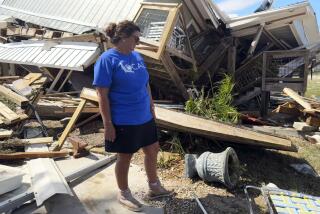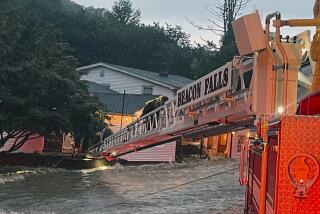Hurricane Sandy shuts down New York City
NEW YORK -- The city that never sleeps resembled one that clearly does.
Even Lady Liberty seemed to doze Monday as she faded in and out of view, shrouded in mist swirling over the whitecaps of New Yorkâs harbor as Hurricane Sandy crept closer to the city. On land, streets that normally are jammed at the start of the workweek were nearly deserted save for emergency workers and gawkers who couldnât resist watching the rivers, the harbor and the sea rise around them.
âI donât think the flood is really going to get all the way to our apartment,â Nicholas Martin said hopefully -- and a bit uncertainly -- as he stood at the end of a street that drops off into the harbor, in Brooklynâs Red Hook neighborhood. He sipped a cup of coffee and watched water rippling in from the harbor and spreading over the street. It crept up the side of a brick warehouse on the avenue, and around a telephone pole, tiny waves rippling in the wind.
His friend, Malinda Brown, said the pair had briefly considered evacuating but opted to stay put, convinced they would be safe. They werenât regretting their decision, at least not yet. Farther up the street, though, others apparently had had a change of heart. Three people hastily piled suitcases and bundles of belongings into a pickup truck and drove off.
PHOTOS: Hurricane Sandy approaches
With Sandyâs full impact still several hours away, sporadic blackouts were beginning, from New Jersey to Connecticut. On suburban Long Island, 54,000 people were without electricity by midday. More than 52,000 people had lost power in New Jersey, and 25,000 were in the dark in Connecticut.
The morningâs high tide sent water washing over some oceanfront boardwalks, parking lots, residential avenues and heavily traveled thoroughfares. Speed limits on bridges were reduced to as low as 20 mph as winds picked up. The gusts proved too much for a construction crane atop a building in midtown Manhattan, at 7th Avenue and West 57th Street. It toppled over and was left dangling in the wind, dozens of stories above the streets, prompting officials to close off the area. There were no immediate reports of injuries.
Officials in Manhattan closed large sections of FDR Drive, which skirts the eastern edge of the island, because of flooding. On Manhattanâs southern tip, in Battery Park, workers piled additional sandbags after the harbor surged over the walkway along the water.
The evening tide was expected to be far higher, and the one after that -- early Tuesday -- higher yet. The Holland Tunnel linking Manhattan to New Jersey, and the Hugh Carey Brooklyn-Battery Tunnel that connects lower Manhattan to Brooklyn, were closed because of potential flooding, and Mayor Michael Bloomberg announced that the city would face a second day of virtual shutdown Tuesday.
Schools were to remain closed, Bloomberg said, and the New York Stock Exchange would also stay dark. Subways were expected to remain closed as well.
MAP: Hurricane Sandy barrels in
âYou can look outside and say, âOh, this is not bad.â Thatâs correct, but it is going to be,â Bloomberg said as he pleaded, yet again, for the roughly 375,000 New York City residents living in flood-prone areas to heed mandatory evacuation orders.
The city set up more than 70 emergency shelters to accommodate people who had no friends or relatives to stay with, but only about 3,000 people had registered at the centers.
That number seemed likely to rise, if the scene at Seward Park High School in Manhattan was anything to go by. As Sandy neared landfall and as rain began pelting streets nearly devoid of the usual signs of city life, people began streaming into the shelter, pushing suitcases and hampers filled with belongings and often leading small children by the hand.
âI expect a big rush later,â said Don West, deputy chief of the Community Emergency Response Team, as two women accompanied by three children checked themselves in. Cots -- 900 of them -- filled the schoolâs two gymnasiums and lined the second-floor hallways. At least 450 had filled up since the shelter opened Sunday night. âI donât know where the overflow goes,â said West.
In the schoolâs auditorium, evacuees sat like bored students at an assembly, watching a small TV blare more Sandy updates as they busied themselves with Sudoko games and crossword puzzles.
Lillian Ward sat on a blue cot inside a gymnasium, hopeful that Monday would be her last of two nights there. Ward lives in one of the cityâs 26 public housing developments in mandatory evacuation zones, and she left after the city warned that it would shut off hot water and power -- including elevator service -- in those buildings to ensure people left.
âThey came and knocked on everybodyâs door Sunday,â said Ward, who felt she had no option: She lives on the ninth floor of her building and didnât want to be stuck there in the dark, having to climb the stairs to her apartment.
Yanira Lassalle also had no choice but to come to the shelter. Thatâs because she was living in a nearby homeless shelter, which ordered everyone out Sunday.
âIâd rather be at the other shelter. At least we have our own rooms there,â said Lassalle, gazing out across a room full of mainly women and children. She was skeptical about the stormâs potential impact, even as the sky darkened outside. âIf it was going to be that bad, it wouldâve been bad already,â she said.
Ward disagreed. âIâm not taking any chances. I just want to wait it out,â she said.
ALSO:
Get blankets, stay off roads, Virginia governor urges
Some in Atlantic City roll the dice with Hurricane Sandy
Hurricane Sandy as âsuper stormâ: Is climate change a factor?
More to Read
Sign up for Essential California
The most important California stories and recommendations in your inbox every morning.
You may occasionally receive promotional content from the Los Angeles Times.











